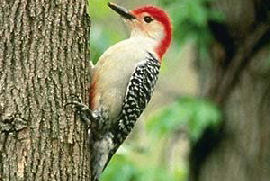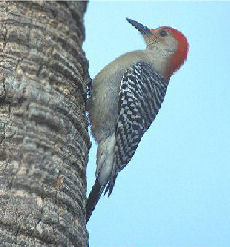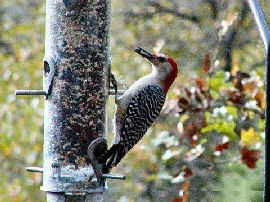Tree-clinging Birds
 |
Red-bellied Woodpecker
Melanerpes carolinus |
Description
10" (25 cm). Barred black and white
above; pale buff below and on face; sexes similar except that male
has red crown and nape, female red nape only. Reddish patch on lower
abdomen is seldom visible in the field.
HabitatOpen and swampy woodlands; comes into
parks during migration and to feeders in winter.
Nesting4 or 5 white eggs in a tree cavity, often
at edge of woodlands.
RangeBreeds from South Dakota, Great Lakes, and
southern New England south to Gulf Coast and Florida. Northernmost
birds sometimes migrate south for winter. |
 |
 |
VoiceChuck-chuck-chuck, descending in pitch.
Also a loud, often repeated churrrr.
DiscussionA common woodpecker over much of the
South, the Red-bellied is scarcer farther north but has expanded its
breeding range northward in recent decades. Like most woodpeckers,
it is beneficial, consuming large numbers of wood-boring beetles as
well as grasshoppers, ants, and other insect pests. It also feeds on
acorns, beechnuts, and wild fruits. It is one of the woodpeckers
that habitually stores food. |